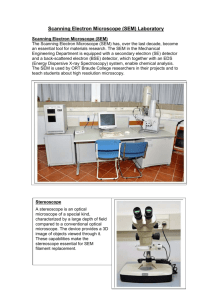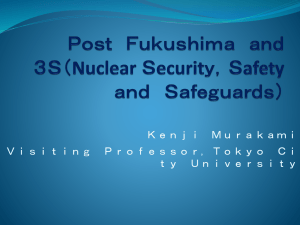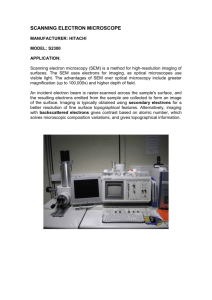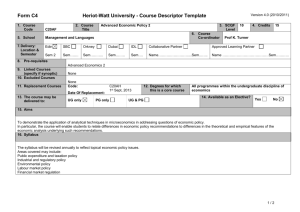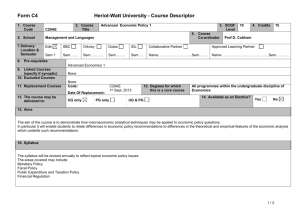Micro-analysis of Environmental Swipe,Spiked and Particle Samples
advertisement
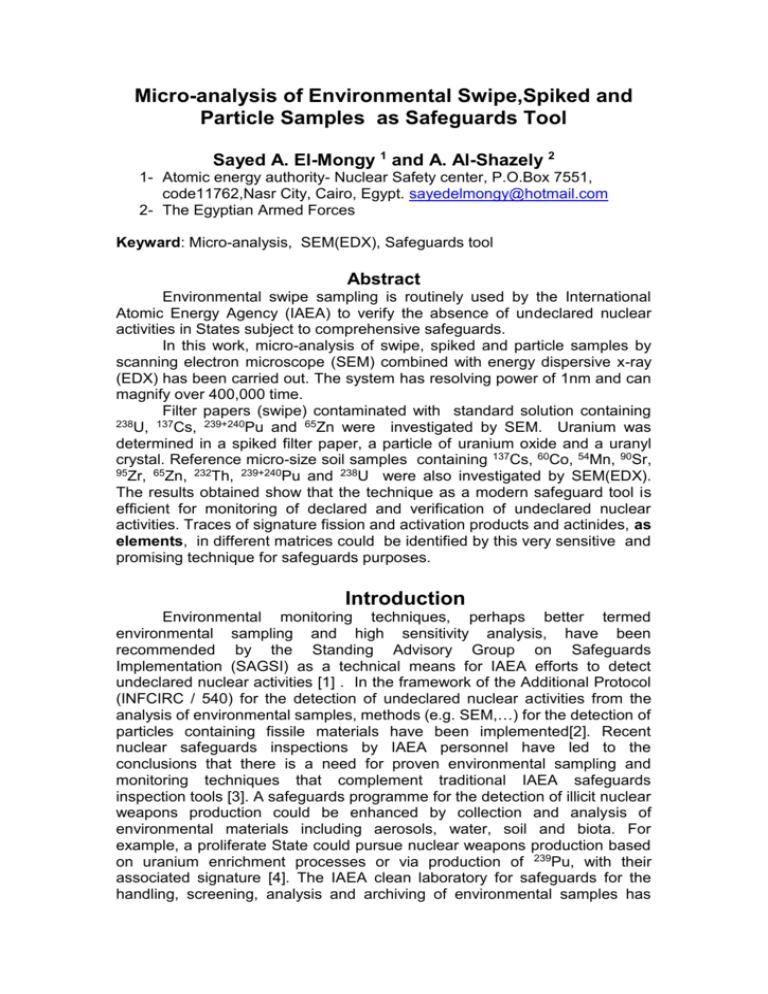
Micro-analysis of Environmental Swipe,Spiked and Particle Samples as Safeguards Tool Sayed A. El-Mongy 1 and A. Al-Shazely 2 1- Atomic energy authority- Nuclear Safety center, P.O.Box 7551, code11762,Nasr City, Cairo, Egypt. sayedelmongy@hotmail.com 2- The Egyptian Armed Forces Keyward: Micro-analysis, SEM(EDX), Safeguards tool Abstract Environmental swipe sampling is routinely used by the International Atomic Energy Agency (IAEA) to verify the absence of undeclared nuclear activities in States subject to comprehensive safeguards. In this work, micro-analysis of swipe, spiked and particle samples by scanning electron microscope (SEM) combined with energy dispersive x-ray (EDX) has been carried out. The system has resolving power of 1nm and can magnify over 400,000 time. Filter papers (swipe) contaminated with standard solution containing 238U, 137Cs, 239+240Pu and 65Zn were investigated by SEM. Uranium was determined in a spiked filter paper, a particle of uranium oxide and a uranyl crystal. Reference micro-size soil samples containing 137Cs, 60Co, 54Mn, 90Sr, 95Zr, 65Zn, 232Th, 239+240Pu and 238U were also investigated by SEM(EDX). The results obtained show that the technique as a modern safeguard tool is efficient for monitoring of declared and verification of undeclared nuclear activities. Traces of signature fission and activation products and actinides, as elements, in different matrices could be identified by this very sensitive and promising technique for safeguards purposes. Introduction Environmental monitoring techniques, perhaps better termed environmental sampling and high sensitivity analysis, have been recommended by the Standing Advisory Group on Safeguards Implementation (SAGSI) as a technical means for IAEA efforts to detect undeclared nuclear activities [1] . In the framework of the Additional Protocol (INFCIRC / 540) for the detection of undeclared nuclear activities from the analysis of environmental samples, methods (e.g. SEM,…) for the detection of particles containing fissile materials have been implemented[2]. Recent nuclear safeguards inspections by IAEA personnel have led to the conclusions that there is a need for proven environmental sampling and monitoring techniques that complement traditional IAEA safeguards inspection tools [3]. A safeguards programme for the detection of illicit nuclear weapons production could be enhanced by collection and analysis of environmental materials including aerosols, water, soil and biota. For example, a proliferate State could pursue nuclear weapons production based on uranium enrichment processes or via production of 239Pu, with their associated signature [4]. The IAEA clean laboratory for safeguards for the handling, screening, analysis and archiving of environmental samples has been fully operational since July 1996[5]. Since sample collection began in January 1996, the priority has been on the establishment of a baseline environmental signature for each facility. In this phase, swipe samples are collected from facility locations identified as having the greatest potential for containing traces of past and current operations. The measurement results from laboratory analyses of the samples are used to characterize the nuclear signature for the facility. Once the baseline is established, requirements for sampling as part of routine activities can be determined. By the end of 1998 swipe samples have been collected at 81 facilities under safeguards agreements. Sampling as a part of routine inspections and design information verification visits, as well as under arrangements provided for by Additional Protocols began in 1998 [6]. By mid november 1996, more than 400 samples shipped and received for analysis in Vienna [7]. By the end of 1998 baseline sample collection had been carried out in 11 enrichment facilities in 7 states and 70 hot cells complexes in 38 states. The collection of environmental samples beyond declared locations when deemed necessary by the IAEA. These techniques and technologies can help verify operations as declared and monitor for undeclared nuclear fuel cycle / nuclear weapons related operations [3] . This work was initiated to analyze and identify traces of signature elements (e.g. fission and activation products and actinides) in different matrices by very sensitive and promising SEM /EDX as a modern safeguards tool. Experimental Work Sample Preparation for SEM Analysis: All the anlayzed samples have been collected and prepared in the central laboratory for radiological measurements and training of the Egyptian atomic energy authority. Many specimens can be brought into the chamber of SEM without preparation of any kind. If the specimen contains any volatile components such as water, this will need to be removed by using a drying process (or in some circumstances it can be frozen solid). Non conducting specimens will charge up under electron bombardment and need to be coated with conducting layer. The layer required to ensure a conducting layer is quite thin (about 10 nm). In all the preparation of specimens to be investigated by SEM is not as complicated [8,9]. The only requirement for preparation of a sample is that it be secured such that it is not going to fall apart in the vacuum system used in SEM. The sample is usually coated with a conductive material (usually gold or carbon ) to reduce charge build up on the specimen but this is not usually essential [10]. Carbon coating is best for situations where chemical make up of the sample as revealed by EDS is important but does not always prove ideal for photography[10]. For a reliable analytical result, the sample preparation must satisfy certain requirement [9] ; (1) The specimen must be flat and smooth especially for quantitative analysis; usually specimens are polished (2) EDX enables analysis of rough specimens; however, application is limited to qualitative and semi- quantitative determinations. (3) The specimen must be electrically and thermally conducting; if necessary, the specimens are coated by means of vacuum evaporation or sputtering with a thin layer of carbon (C) or gold (Au). Specification of the Scanning Electron Microscope Used The XL-30 Philips (in the central laboratories) used in this work for scanning of the samples of interest consists of an electron optical column, vacuum system and electronics. There are three lenses (electromagnetic lenses) to focus the electrons into a fine spot onto the specimen. The specimen chamber, on the other hand, is larger because the SEM technique does not impose any restriction on specimen size other than that set by the size of the specimen chamber[11]. The electron gun, tungsten filament, at the top of the column produce the electron beam which is focused into a fine spot less than 4 nm in diameter on the specimen. This beam is scanned in a rectangular raster over the specimen. Increasing the magnification is achieved by reducing the size of the area scanned on the specimen recording is done by photographing the motion screen (or, more usually a separate highresolution screen), or making video prints [8,12]. The XL-30 has resolving power of 1nm and can magnify over 400,000x [8,12]. Quantitative analysis can now be performed with relative accuracy approaching 1%. The more similar the standards are to the unknowns, the more accurate will be the analysis. The Clean Laboratory (Seibesdorf - IAEA) is also equipped with a Philips XL- 30 scanning electron microscope with energy dispersive X-ray (EDX) detection systems[13]. Energy Dispersive Spectrometer : X-ray spectra and X-ray maps were measured with an energydispersive spectrometer equipped with a thin window Si(Li) detector[14] .The intensity of energy characteristic x-ray is proportional to the concentration of the element in the specimen producing the x- ray. X-rays create pulse heights in the EDX which depends on the energy of the incoming x-ray. These pulses are collected by multi channel analyzer (MCA), so that EDX collects simultaneously a complete spectrum. Currently, energy dispersive x-ray spectrometers are widely used on SEM’s. EDX consists of a detector, mounted in a tube and cooled by liquid nitrogen(the electronics are near the detector which also require cooling) and the multichannel analyzer (MCA) that processing data (fig.1). The detector consists of a collimator that ensures that x –rays generated from parts of the SEM column or chamber does not reach the detector. The x-ray detector is normally separated from the specimen by a window, which is transparent to xrays, whilst at the same time securing a vacuum in the region of the detector when the chamber area is vented. The detector itself consists of lithium-doped silicon coated at the front with a thin layer of gold. The x-rays produce charge pulses in the Si that are proportional to their energy and x- rays of all energies are detected virtually simultaneously [8,12]. At room temperature, with this voltage applied, a current of a few microamperes would flow. This would mask the small charge from x- rays, so the detector is cooled to temperatures near that of liquid nitrogen. The current is then reduced to less than 1x10-13 amperes, and becomes negligible compared to the x-ray charge. This low temperature also prevents the lithium atoms from moving about the silicon lattice. Figure(1) : Schematic Representation of an EDX The System Detection Limit X-rays can be generated depending on the initial electron –beam energy and atomic number. Assuming a typical density of 7 g / cm 3 for a transition metal, the composition of 7x10-12 g of material can be determined. From this small mass of the sample selected by the electron x-ray interaction volume, elemental constituents can be determined to concentrations ranging as low as 0.01%, which corresponds to limits of detection in terms of mass of 10 -16 to 10-15g [12]. The ability to detect 10-16 to 10-15 g of an analyte suggest that use of the SEM is a trace-analytical technique. Based on the practical observation that energy –dispersive X-ray spectrometry in the SEM has limits of approximately 0.1 wt %. The presence of element about 10 5 to 106 atoms is being detected by the technique[15]. Results Environmental swipe sampling is routinely used by the International Atomic Energy Agency to verify the absence of undeclared nuclear activities in States subject to comprehensive safeguards[13]. Environmental swipe sampling at a facility involves two phases. In the first phase, the baseline is measured by taken samples from locations identified as having the highest potential for containing traces of past and current operations[16]. The purpose of the baseline is to characterize the traces of nuclear activities detectable at the site. In the second phase, samples are taken during subsequent inspection from randomly selected locations sampled during the baseline. The results are compared to the baseline to detect changes or inconsistencies [16]. The analysis of micrometer–sized particles taken from swipe samples involves a number of highly sensitive and selective methods for the determination of actinide elements and fission products[13]. Scanning electron microscopy combined with X-ray fluorescence spectrometry has been used to study U and Pu-containing particles taken from inside hot cells and in a few Cm2 of swipe samples [13,17]. SEM (EDX) has been used in this work for identifying many signature elements. Filter paper (swipe) contaminated with standard solution of the IAEA’s containing some radionuclides in microgram level (e.g. cesium – 137, Zinc–65, plutonium-239+240 and uranium) was scanned by electron microscope (EDX). The results indicate the cabability of the system to detect fission and activation products and actinide as elements (e.g. Cs, Zn, Pu and U) that may be released from undeclared or declared nuclear activities. Figure(2) shows results of the analysis of swipe samples contaminated with uranium solution (1 ml of 1 mg/g uranyl nitrate solution). It was a quite diffuclt to identify uranium by the SEM in these samples. Six images were taken at different magnification power for different spots of the sample. The highest trace concentration was found to be ~ 1 wt %. The filter papers were scanned before its contamination as a background.. Concentration Wt % 1.5 1 0.5 0 image1 image2 image3 image4 image5 image6 Im ages Figure (2) : The Results of SEM Analysis of Filter Paper Contaminated with Uranium (swipe samples) The image with the brightest spot containing uranium element of the scanned sample is shown in Figure (3). Figure(3): The Image of the Filter Paper Contaminated with Uranium A particle of uranium oxide was also investigated by SEM with high efficiency. Eight images for different spots at varied magnification power were taken to the sample. More than 90 wt% of uranium was easily identified (Figure 4). This result reflects the importance and efficacy of SEM(EDX) in the low concentration analysis of the safeguarded nuclear materials. w t% Concentration 100 80 60 40 20 0 Image1 Image2 Image3 Image4 Image5 Image6 Image7 Image8 Figure (4): The Results of SEM Analysis of Uranium Oxide Particles An image showing the micro-structure of uranium oxide is given in Figure (5). Figure(5): The Image of Uranium Oxide Particle Scanning In other work, uranium oxide particles of ~ 1 um diameter with four different enrichment (0.5% , 1%, 3% and 10%) were characterized by SEM for their morphological properties (2). In this work, uranyl nitrate crystals were also investigated by SEM. Many images for different spots were taken to identify uranium in uranyl nitrate particles. The highest concentration of uranium (~ 80 wt %) was observed in the eleventh image. The typical spectrum taken by EDX for the uranyl nitrate particle showing the characteristic x-ray peaks of uranium and the other identified elements (e.g. O ,N and C) is given in the Figure (6). Fig. (6): The Spectrum of Uranyl Nitrate Particle Analysis Five micro-size particle of soil samples were scanned by the SEM(EDX). The results show the presence of the natural clay minerals only; Si, K, Ca, Al, and Fe. These samples were then contaminated (spiked) with trace concentration ( ug level ) of radioisotopes (238U, 90Sr, 232Th, 210Pb, 60Co, 65Zn, and 54Mn) to be re-analyzed by the SEM (simulation for tracing of radiocontaminants that may released from declared or undeclared nuclear facilities). The analysis shows the presence of uranium . thorium, Sr, cobalt, zinc and manganese elements. The analysis of the spiked soil particles without any chemical treatment is not easy work. In different spots, the SEM could not identify many elements in the samples due to the background interferrence. One of the image is given in Figure (7) . Figure (7): The Image of the Spiked Soil Particle In general, identification of the radioactive particles from numerous non-active species is tedious task because the composition of the metallic background particles of artificial origin varied greatly, and the number of suspicious particles in a sample is very large [14]. Unfortunately, the uses of chemically harsh method often destroy the soil matrix and liberates the geologically bound metals, when a sample is assayed for environmental contamination metals[18]. In this work,the SEM has also been used for identifing signature elements in reference sample (IAEA-375). The sample contains many radioactive isotopes; 90Sr (108 Bq/kg) , 232Th (20.5 Bq/kg), 241Am (0.13Bq/kg), 129I (0.0017Bq/kg) and 239+240Pu (0.3Bq/kg). Figure (8) show results of scanning of the particle sample with the identified elements. U w t% Sr 2 Th Am 1.6 I 1.2 Ra 0.8 Pu 0.4 0 Image5 Image6 Image7 Figure (8): The Results of the SEM for IAEA`s Reference Material The identified elements are of great importance for environmental safeguards analysis. Other work show that precise measurements of actinide element ratio such as uranium/plutonium or amercium/plutonium in particle give information about the irradiation history of the uranium and reveal whether chemical separation operation have been carried out (19). In this work, scanning of the IAEA ,s reference sample (soil7) was also carried out by SEM. This sample contains ; U (2.6ug/g), Zr (185ug/g), Co (8.9ug/g), Th (8.2ug/g), Zn (104ug/g), Sr (108ug/g), La (28ug/g), and Mn (631ug/g). All these elements from were also identified in different spots of the scanned particles . 2 2 1 1 0 0 Recently, the concept of a “Microstructural fingerprint” of a material has been developed as a complement to the “isotopic fingerprint” in the characterization of samples in nuclear forensic science (2,20). Conclusions The signature elements ; Cs, Sr, Th, U, Am, Pu, Co, I, Zn, Zr, La and Mn were identified with trace concentration in the investigated swipe, spiked and particle samples. The micro-analysis results obtained by the SEM(EDX) are efficient to monitor the declared and to verify the absence of undeclared nuclear activities. The technique can also be used for analysis of nuclear materials (e.g. U3O8) in different stages of the front-end of the nuclear fuel cycle and environmental safeguards. Acknowledgement The authors would like to thank Prof. Dr. Mona Mohsen. and Prof. Dr. A.M. Osman for their valuable discussion. References [1] I.N. Goldman, “Environmental Sampling and Analysis” ,IAEA-SM-33\97, International Nuclear Safeguards proceedings,Vol.1, (1994) . [2] Annual Report, “ Safeguards Research and Development”, ITU. JRC . CEC . EU. .Int. , Germany, 1999. [3] D.W. Swindle, Jr., L. J. Holcombe, “Application of Commercial Environmental Measurement and Analysis Techniques for the Monitoring and 80 75 70 65 2 2 1 1 0 0 60 I m a1g e I m a2g e I m a3g e Detection of Nuclear Fuel Cycle Activities”, IAEA-SM-333\96, International Nuclear Safegurads, Vol.1, (1994). [4] N.A.Wogman, R.W.perkins, G.R.Holdren, “Environmental Sampling and Analysis as Safeguards Tool”, IAEA-SM 333 \ 98, International Nuclear Safeguards, proceeding Vol.1, (1994). [5] Jill N. Cooley and kenji Murakami, “Implementation of the Additional Protocol” Proceedings of the 21St ESARDA Int, Conf., Seville, Spain, (1999). [6] Erwin kuhn, Diane Fischer, Mikhail Ryinski and Michael Taylar, “Recent Progress in the IAEA,s Environmental Sampling for Safeguards” Proceedings of the 21St ESARDA Int. Conference, Seville, Spain, (1999). [7]IAEA Bulletin,“Safeguards and Industry”,Vol.38,No.4,Vienna,Austria (1996). [8] Philips Scanning Electron Microscope Manual, Holland, (1996). [9] Scotte, Love and Reed “Quantitative Electron –Probe Microanalysis”-USA, second edition (1995) [10] G.Norman White and Joe B. Dixon “ Scanning Electron Microscopy of Minerals in Soils”TSEMJ Vol. 26:1,(1995). [11] Joseph I.Goldstein, dale E.Newbury, Patrickechlin, David C. Joy, A.D.Romig, Jr., Charles E.Lyman, Charles Fiori, and Eric lifshin, “Scanning Electron Microscopy Microanalysis”, USA, Second Edition, (1994). [12] Scanning Electron Microscope X-L 30 Catalog,(1997) [13] D.Donohue, J. Parus and A.Ciurapinski, “Scanning Electron Microscope Studies of U And Pu- Containing particles from Environmental Swipe Samples”, Proceeding of the 21 st ESARDA, Int. Conf., Seville, Spain, 1999. [14] R.Pollanen, S. klemolla, T. K. Ikaheimonen, K. Rissanen, J. Juhanoja, S. Paavolaninen and J. Likonen, “Analysis of radioactive particles from the Kola Bay Area” Analyst, 126, 724-730, 2001. [15] Ron Jenkins, R.W. Gould, Dale Gedcke “Jenkins, Quantitative X-ray Spectrometry”,2nd ed. Marcel Dekker Inc. (1995). [16] E.Kuhn, “Environmental Sampling”, Technical Workshope: “Safeguards: Its Verification Technologies and Related Experience”, IAEA,12-15 May 1997. [17] D.Donohue, “ Environmental Sampling”, 24th Annual Meeting of ESARDA, R&D responses to the new safeguards envi., 28- 30 May, Luxembourg (2002) [18]http://www.chem.vt.edu/chem-dept/long,files/e nvironment.html,1/7/2002 [19] D. Donhue,” Key Tools for Nuclear Inspectios”, Advances in environmental Sampling Strengthen Safeguards, IAEA Bulletin 44(2) 2002. [20] “Environmental Monitoring for Nuclear Safeguards”, OTA – BP-ISS-168. GPO stock # 052-003-01442-4, Sept. 1995.
